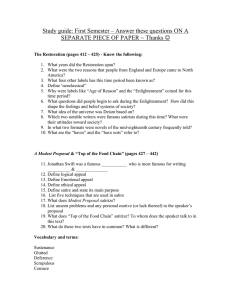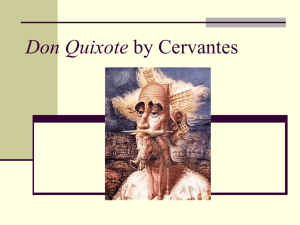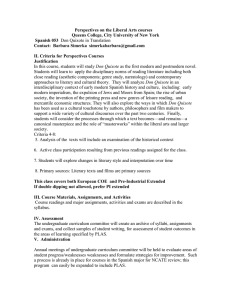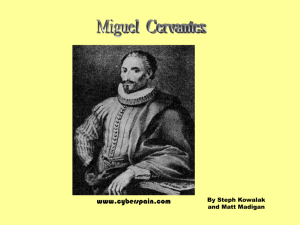FIRST PAPER 21L706 FILM AND
advertisement
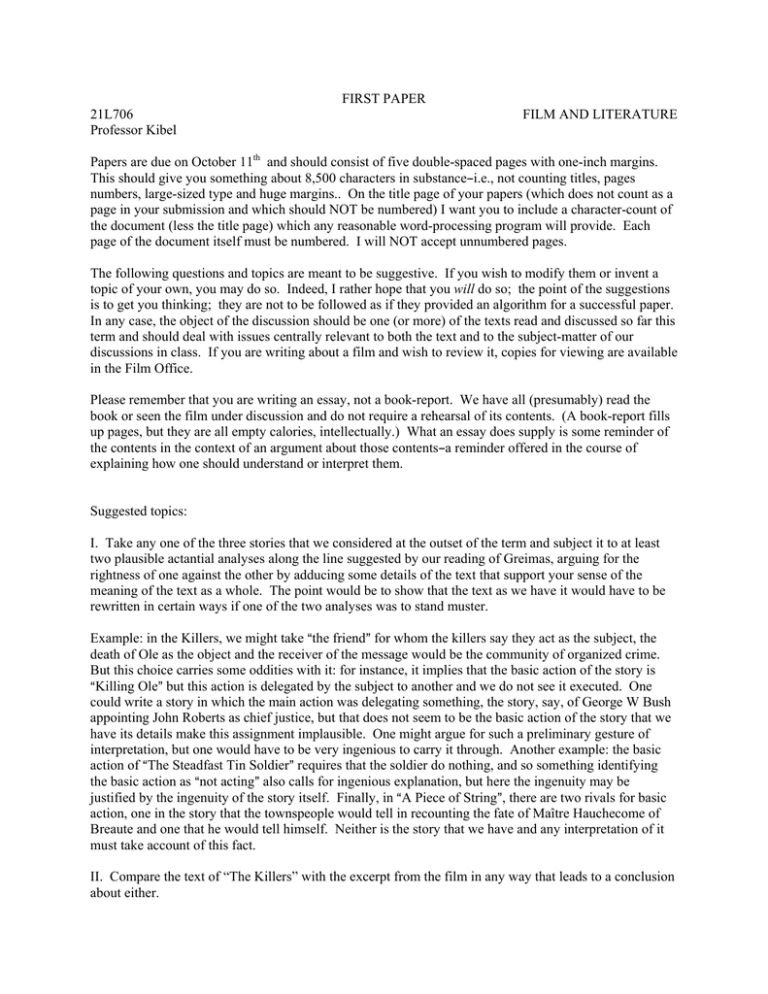
FIRST PAPER 21L706 Professor Kibel FILM AND LITERATURE Papers are due on October 11th and should consist of five double-spaced pages with one-inch margins. This should give you something about 8,500 characters in substanceBi.e., not counting titles, pages numbers, large-sized type and huge margins.. On the title page of your papers (which does not count as a page in your submission and which should NOT be numbered) I want you to include a character-count of the document (less the title page) which any reasonable word-processing program will provide. Each page of the document itself must be numbered. I will NOT accept unnumbered pages. The following questions and topics are meant to be suggestive. If you wish to modify them or invent a topic of your own, you may do so. Indeed, I rather hope that you will do so; the point of the suggestions is to get you thinking; they are not to be followed as if they provided an algorithm for a successful paper. In any case, the object of the discussion should be one (or more) of the texts read and discussed so far this term and should deal with issues centrally relevant to both the text and to the subject-matter of our discussions in class. If you are writing about a film and wish to review it, copies for viewing are available in the Film Office. Please remember that you are writing an essay, not a book-report. We have all (presumably) read the book or seen the film under discussion and do not require a rehearsal of its contents. (A book-report fills up pages, but they are all empty calories, intellectually.) What an essay does supply is some reminder of the contents in the context of an argument about those contentsBa reminder offered in the course of explaining how one should understand or interpret them. Suggested topics: I. Take any one of the three stories that we considered at the outset of the term and subject it to at least two plausible actantial analyses along the line suggested by our reading of Greimas, arguing for the rightness of one against the other by adducing some details of the text that support your sense of the meaning of the text as a whole. The point would be to show that the text as we have it would have to be rewritten in certain ways if one of the two analyses was to stand muster. Example: in the Killers, we might take Athe friend@ for whom the killers say they act as the subject, the death of Ole as the object and the receiver of the message would be the community of organized crime. But this choice carries some oddities with it: for instance, it implies that the basic action of the story is AKilling Ole@ but this action is delegated by the subject to another and we do not see it executed. One could write a story in which the main action was delegating something, the story, say, of George W Bush appointing John Roberts as chief justice, but that does not seem to be the basic action of the story that we have its details make this assignment implausible. One might argue for such a preliminary gesture of interpretation, but one would have to be very ingenious to carry it through. Another example: the basic action of AThe Steadfast Tin Soldier@ requires that the soldier do nothing, and so something identifying the basic action as Anot acting@ also calls for ingenious explanation, but here the ingenuity may be justified by the ingenuity of the story itself. Finally, in AA Piece of String@, there are two rivals for basic action, one in the story that the townspeople would tell in recounting the fate of Maître Hauchecome of Breaute and one that he would tell himself. Neither is the story that we have and any interpretation of it must take account of this fact. II. Compare the text of “The Killers” with the excerpt from the film in any way that leads to a conclusion about either. III. Apply the pattern of the basic schematism to The Matrix and discuss how it helps to elucidate the film. How does the ability of the Oracle to foresee the future relate to Neo’s ambition to control his own life? Consider the assignment of the function Asender@Bis it Sion? or is it, as the ending of the film seems to imply, Neo, who would be, then, both subject and sender? IV. Write upon any of these suggested topics relating to Don Quixote: The famous novelist, Thomas Mann, in an essay on Don Quixote, expressed astonishment at the so-called "interpolated" stories in the book--the early story about Crysostom, who died of love for the shepherdess Marcela, the tale of Lucinda, Dorothea, Don Fernando, and Cardenio, the story of Anselmo and Lothario, the Turkish Captive's Tale (which actually incorporates details from Cervantes's own captivity), the goatherd's story. The book mocks the unrealities of tales of knight errantry, Mann complained, and yet it presents stories written in a similarly unrealistic style. We have not read any Abooks of chivalry@ (although Cervantes provides a plot summary or general outline for the genre) but we must suppose that although both they and the interpolated tales are "unrealistic" from a twentieth-century viewpoint, the interpolated tales and the tales of chivalry in the view of Cervantes and his contemporaries were not unrealistic in the same way. The point about serious literature, for Cervantes, was not that it should be realistic but that it should be "truthful"--meaning by this that it should responsibly illustrate general truths about human relationships and do so in an ingenious way. (The point is made occasionally in the text by characters discussing narratives that they have read or listened to.) Comment. Discuss the relation between Don Quixote and Sancho in any way that seems interesting. Is Sancho essential to the conception of the book? Is he more sensible than Don Quixote, less sensible, closer to reality or equally mad but in a different way? The parts of Cervantes's novel that deal with the adventures of the knight and his squire are full of tricks that would mock any reader proposing to take the story seriously. By means of a number of narrative devices (the chapter headings, for example, or the suspension of narrative in mid-combat, when the author complains that his historical sources have run out) and other gimmicks, one is constantly reminded that-whatever the overall purpose of book--one is reading a narrative entertainment, not the sort of narrative that the canon or the curate would approve of as a serious or responsible work of literature. Discuss some of these tricks or jokes and their effect upon the reader. Discuss the regard that men have for women they have pledged themselves to in Don Quixote--the attitude of the knight-errant to her who is the source of power in his mighty arm (insofar as love of her keeps him faithful and pure), the attitude of Cardenio, who lost his faith in his beloved and went mad, the attitude of Anselmo, who could not have faith without proof or testing (an attitude taken up in mockery towards Dulcinea by two of those whom Don Quixote meets, when he demands that they profess faith in her.) V. Discuss the idea of fate and fated deeds, together with idea of enchantment, as it figures in Don Quixote and The Matrix. How would you compare the two unenchanted worldsBthe world of Cardenio and the Turkish captive, on the one hand, and the world of the spaceship Nebuchadnezer, which does not exist in the world created by the Matrix, on the other? Which pill would Don Quixote take, the red pill or the blue? And why? VI. Discuss the ideal of heroism in Seven Samurai. How would you map a basic schematism for this story? How would you line up the relations of the characters? How would you articulate the ideal of heroism that it means to express? What is the theme that best expresses the point of the story, as you understand it?
